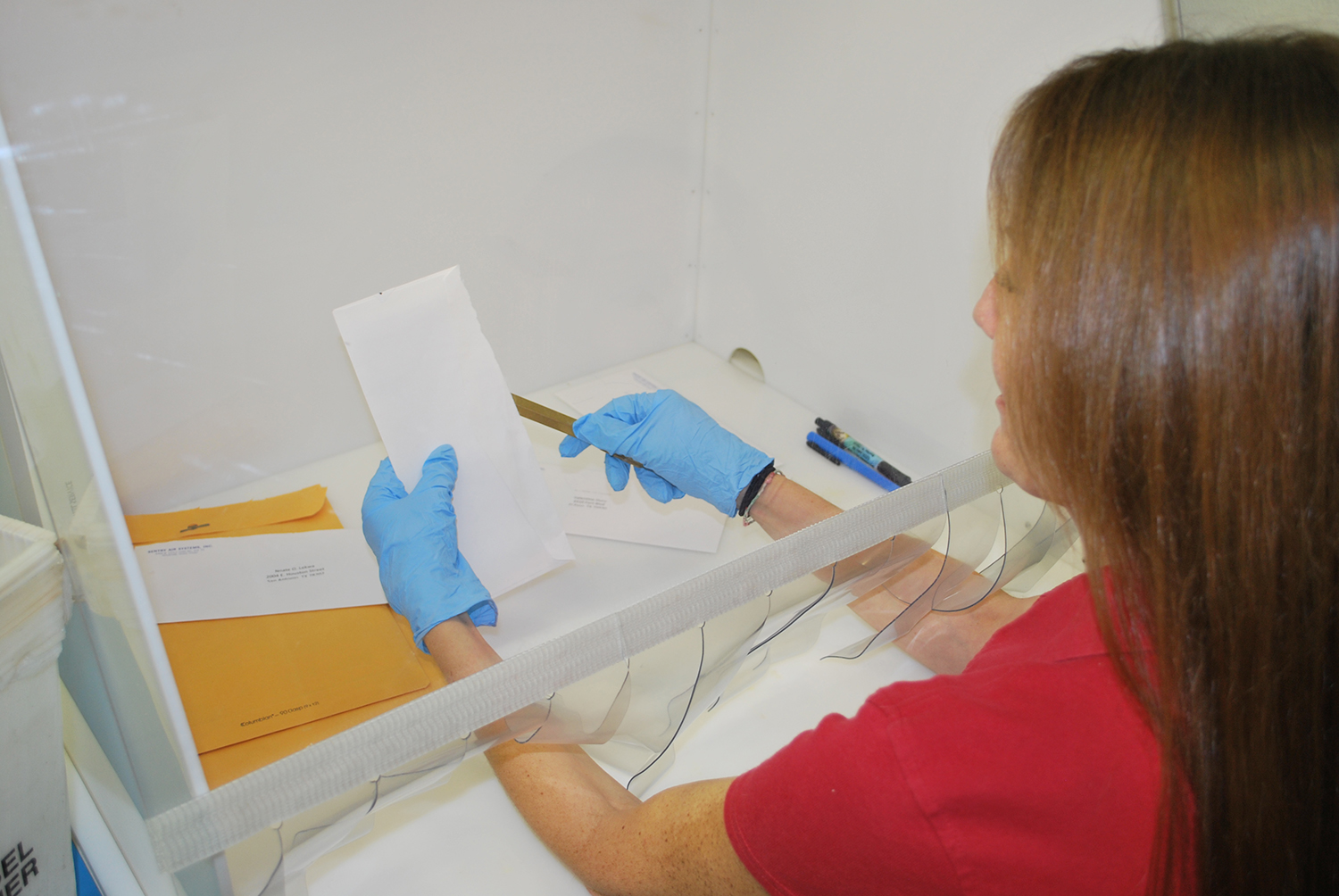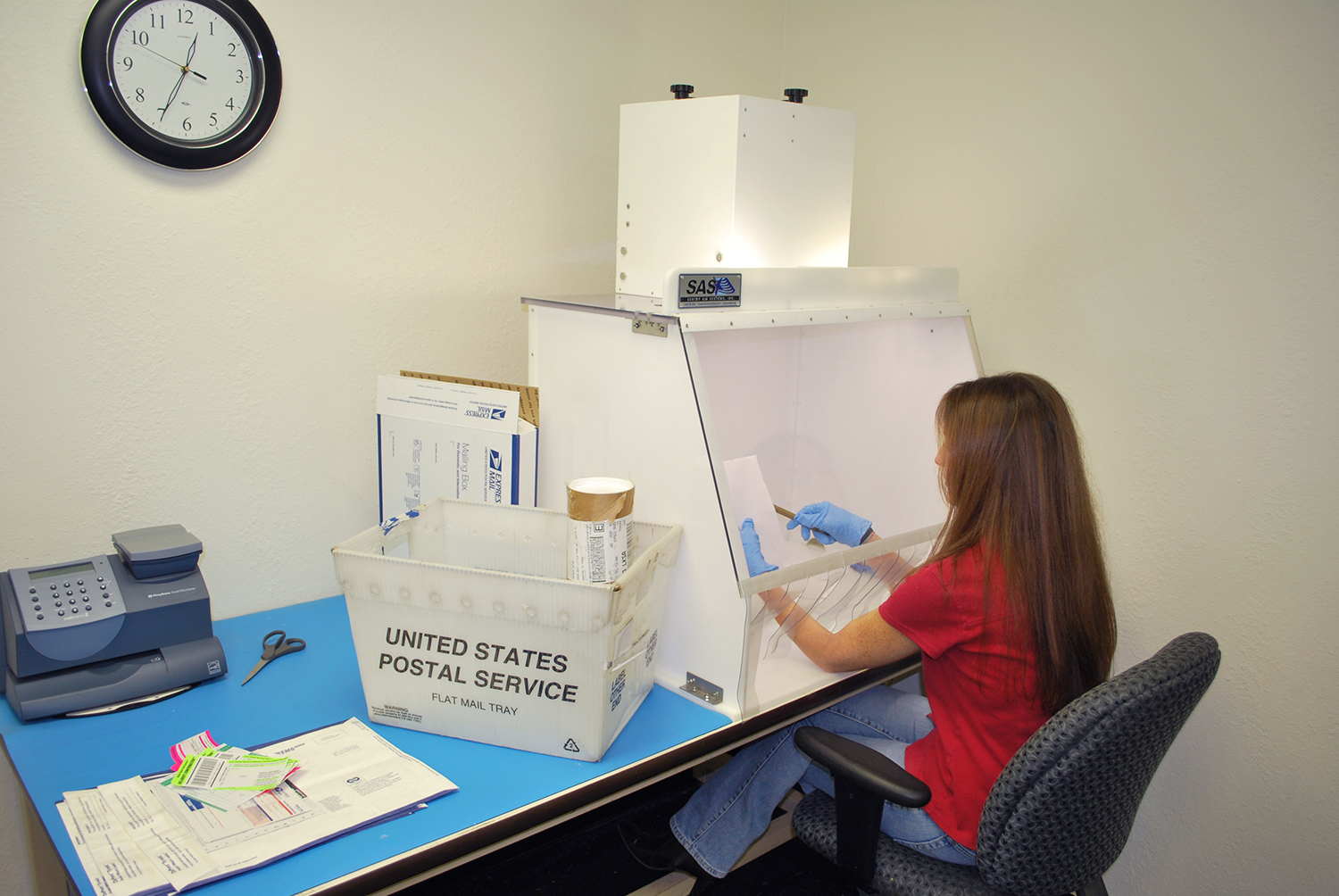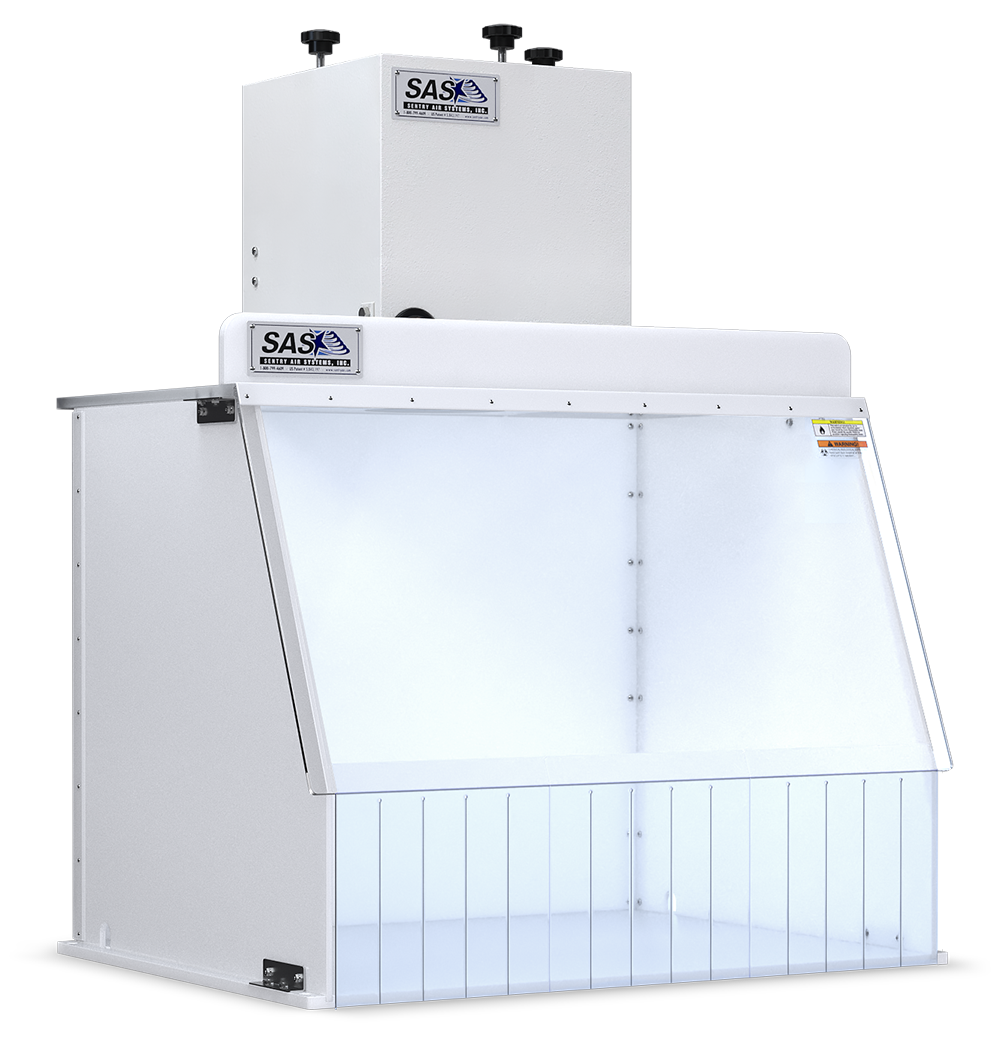
Facilities can help protect operators from mail-borne health hazards by utilizing engineering controls such as Mail Safety Containment Hoods.
To minimize safety concerns, mail-handling procedures at private mailrooms should follow safety guidelines and implement engineering controls to minimize staff exposure to pathogens, particulate, and biohazards. On average, about 6,300 mail-borne incidents are reported every year to the Bureau of Alcohol, Tobacco, Firearms, and Explosives (ATF) and the U.S. Postal Inspection Service (USPIS) (Newman, 2023). Top mail-borne threats include white powders and liquids in letters, hoax devices, chemical and biological agents, and radiological (Newman, 2023). For safer mail handling, the USPS and the Department of Homeland Security recommend that private mailrooms that sort, distribute, or handle mail parcels can help protect themselves by implementing engineering safety controls such as Mail Safety Containment Hoods (USPS & Homeland Security).
Mail Handling Safety Concerns
Hazardous agents and particulates can generally be categorized into three groups: chemical, biological, and radiological (USPIS). Due to mail routinely being X-rayed and screened for radioactivity, radiological hazards are commonly addressed and very rarely cause a threat or harm to an individual handling the mail. However, chemical and biological hazards pose the biggest threat to individuals handling mail. When aerosolized from handling the letter or package, chemical and biological agents can result in chronic and acute health effects. Containing airborne particulate in a Mail Safety Containment Hood can help reduce individual exposure to chemical agents and biohazards.
What is a Biohazard?
The term biohazard refers to any biological material including microorganisms, plants, animals, or byproducts of said living organisms, that pose a threat to their health. According to the Center for Disease Control (CDC), there are 4 distinct levels of biohazards (CDC):
• Biohazard Level 1: Agents that pose minimal threat to humans and the environment.
• Biohazard Level 2: Agents that can cause severe illness in humans and are transmitted through direct contact with infected material. Examples include HIV, hepatitis B, and salmonella.
• Biohazard Level 3: Pathogens that can become airborne and cause serious diseases.
• Biohazard Level 4: Pathogens that pose a high risk of life-threatening disease for which there are no treatments.
Mail Handling Safety Recommendations

Mail Safety Containment Hoods. enclose the mail to help prevent exposure to the operator.
Despite several shipping regulations put in place due to the anthrax scare and The World Trade Center being attacked in 2001, several biohazards such as fentanyl and other substances that are harmful when inhaled, or absorbed are often sent via mail. Government organizations such as the CDC, FBI, OSHA, and Department of Homeland Security have partnered with the U.S. Postal Service to improve mail handling safety.
According to the Department of Homeland Security, improving mail handling safety is best remedied with set handling procedures and utilizing safety controls including (Homeland Security):
Engineering Controls – Engineering controls such as Mail Safety Containment Hoods or Ductless Fume Hoods utilize a powerful fan to draw ambient air into the hood to create an airflow. This flow of air directs airborne contaminants from the mailing pieces away from the operator’s breathing zone into the filtration chamber. HEPA filters provide up to 99.97% efficiency on particles down to 0.3 microns in size. The filtered air is then recirculated into the surrounding room. Engineering controls offer the most effective method to prevent operator exposure.
Administrative Controls – Administrative controls entail limiting exposure by reducing the number of staff or employees involved with handling mail.
Housekeeping Controls – To reduce harmful dust from becoming airborne, all surfaces must be cleaned using wet methods or a vacuum.
Personal Protective Equipment (PPE) – Workers should wear nitrile gloves and N95 masks to reduce exposure to biohazards. OSHA suggests the use of nitrile gloves versus latex due to concerns of allergy and sensitivity problems which would not offer sufficient protection.
Mail Handling Safety Containment Hood

Ductless Fume Hoods provide a great solution for improving facility mail handling safety.
Mail Safety Containment Hoods or Ductless Fume Hoods separate the operator to help prevent exposure to potential biohazards, airborne pathogens, and particulate during the handling, sorting, and distribution of envelopes and small packages. These systems utilize a powerful fan to draw ambient air and particulate from under the hood into the filtration chamber. A HEPA filter processes the air and releases the filtered air into the surrounding room. For finer particulate, ULPA filters can be utilized to provide a higher efficiency (up to 99.995% efficiency on particles down to 0.12 microns).
Benefits:
• Draws most of the harmful biohazards away from the operator’s breathing zone
• Creates a contained area to physically separate the user from mailing pieces
• Makes a recirculating airflow pattern
• No external ductwork or makeup air
• Simple installation
• Expert support
• Made in the USA
Filters: HEPA (up to 99.97% efficiency on particles down to 0.3 microns) or ULPA (up to 99.995% efficiency on particles down to 0.12 microns)
Sizes Available: 24”, 30”, 40”, 50”, 60”, and 70”
Airflow: up to 350 CFM
Inlet Velocities: all sizes provide at least 100 FPM meeting OSHA standard
Contact us today to improve your facility’s mail handling safety with Mail Safety Containment Hoods to control biohazards and other mail-borne health hazards!
Call us today at 1-800-799-4609
References
CDC. Recognizing the Biosafety Levels. Retrieved from: https://www.cdc.gov/training/QuickLearns/biosafety/
Homeland Security. Best Practices for Safe Mail Handling. Retrieved from: https://www.fbiic.gov/public/2010/nov/safe_Mail_Handling.pdf
Newman, Bernard (2023). Top 10 Practices for Secure Mail and Safe Package Handling. Security Info Watch. Retrieved from: https://www.securityinfowatch.com/perimeter-security/threat-detection-imaging-inspection/article/53056853/top-10-practices-for-secure-mail-and-safe-package-handling
USPIS. Who Protects Your Mail? Guide to Mail Center Security. Retrieved from: https://about.usps.com/publications/pub166.pdf
USPS. Handling and Processing Mail Safely. Retrieved from: https://about.usps.com/publications/pub166/pub166_v04_revision_112019_tech_015.htm

 Made in the USA
Made in the USA